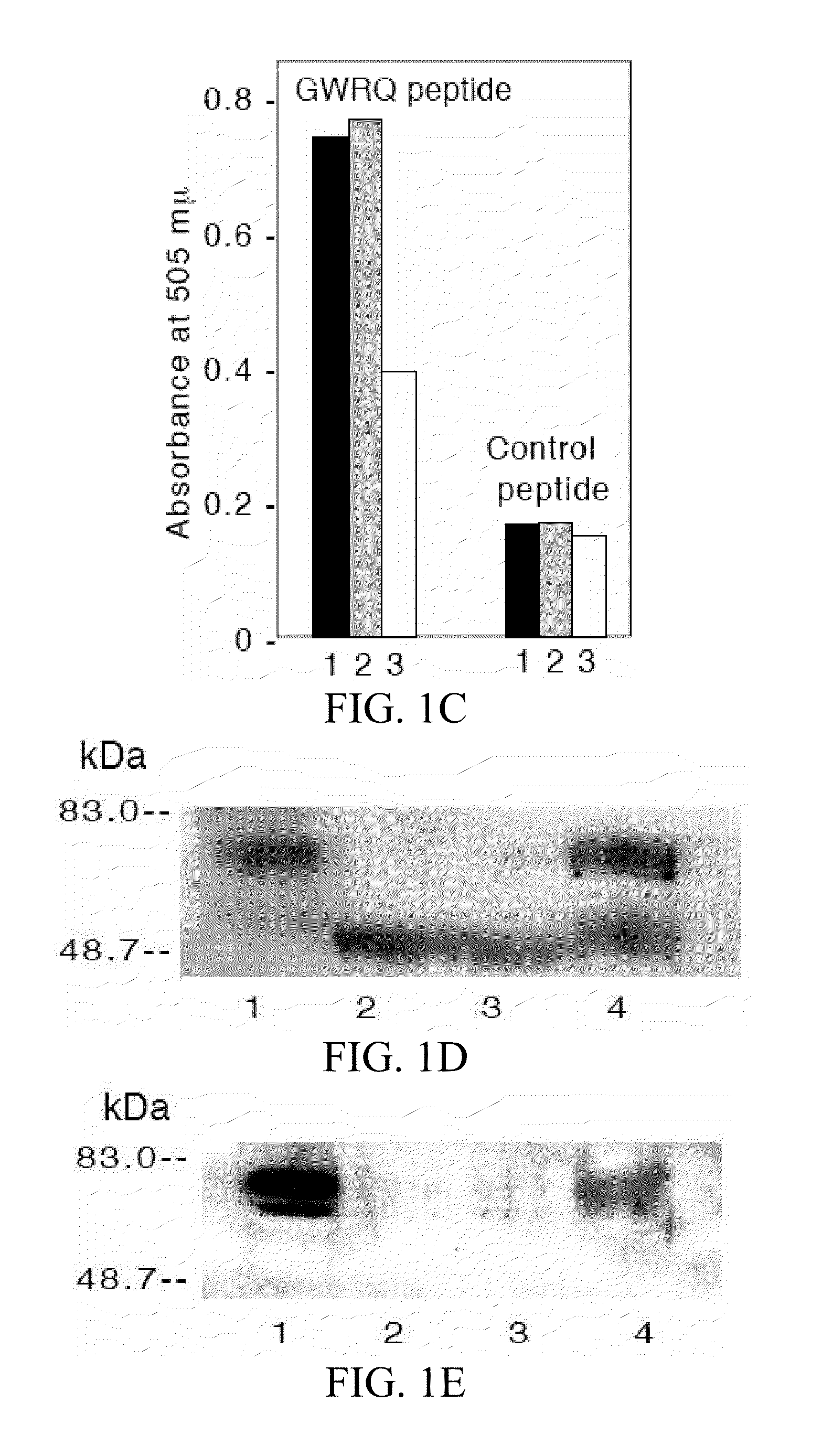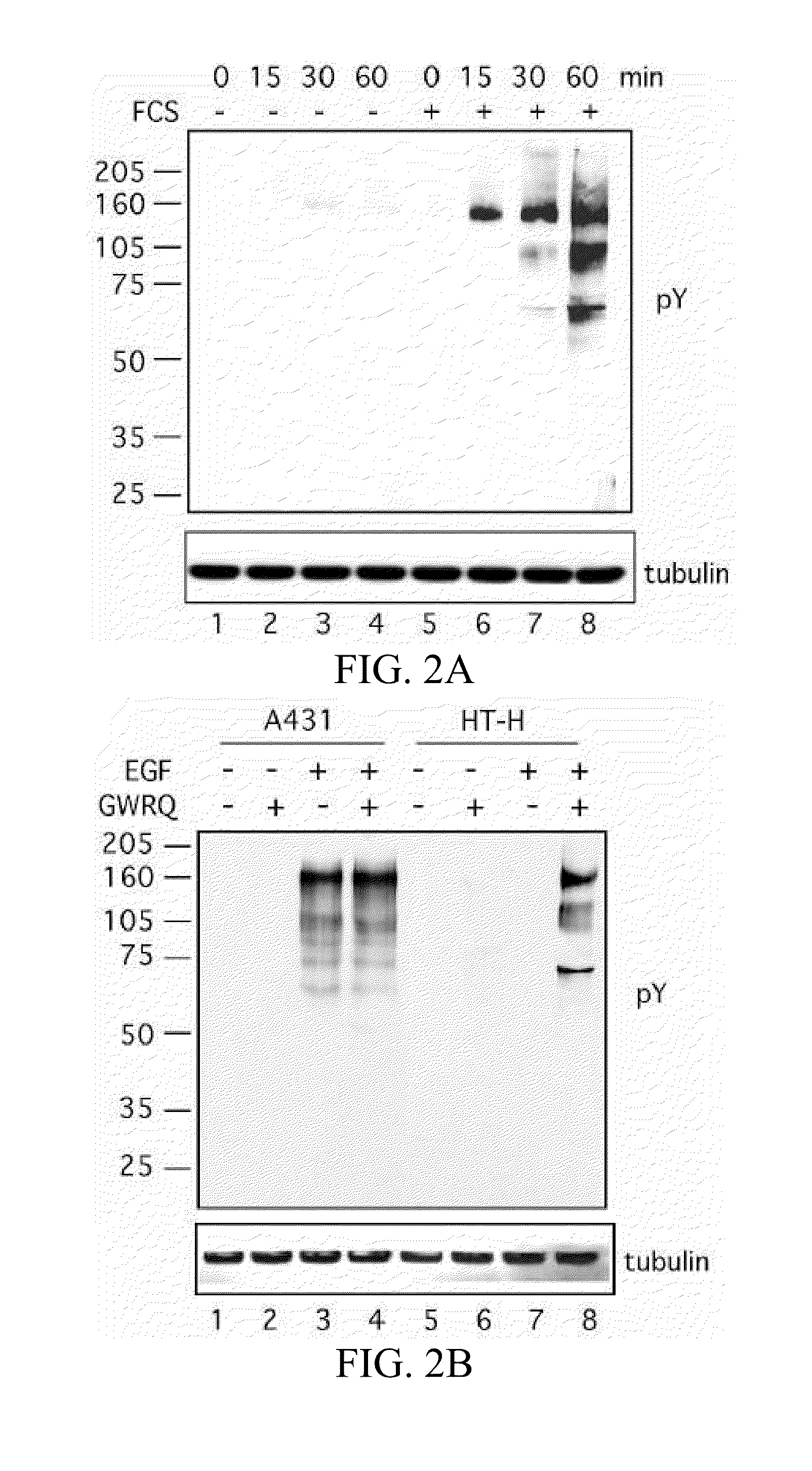Trophinin-binding peptides and uses thereof
a technology of trophinin and peptides, which is applied in the field of trophinin-binding peptides, can solve problems such as deficiency of sperm motility
- Summary
- Abstract
- Description
- Claims
- Application Information
AI Technical Summary
Problems solved by technology
Method used
Image
Examples
example 1
1. Example 1
Trophinin-Mediated Cell Adhesion as a Molecular Switch for EGF Receptor Activation in Human Embryo Implantation
[0264]i. Results
[0265]The trophoblastic embryonal carcinoma HT-H line was used as a model for trophectoderm cells of the human blastocyst (Fukuda, M N, et al. 1999). The HT-H cells adhered with high affinity to the apical surface of trophinin-expressing endometrial adenocarcinoma cells. Morphological changes in the HT-H cells indicated that trophinin-mediated cell adhesion activated signaling in these cells. Indeed, the binding of suspended HT-H cells to an HT-H cell monolayer caused significant elevation of tyrosine phosphorylation (24.5±2.06% of positive cells vs. control 0.8±0.75%, n=5).
[0266]HT-H monolayer was incubated in medium containing Na3VO4, overlayed with (right) or without an HT-H cell suspension, and stimulated for phosphorylation at 37° C. for 30 min. Adhered HT-H cells were removed by gentle pipetting, and the HT-H monolayer was stained with anti...
example 2
2. Example 2
The Trophinin-Binding Peptide GWRQ Promotes Human Sperm Motility
[0326]i. Introduction
[0327]Trophinin mediates apical cell adhesion between trophectoderm and endometrial epithelia, through trophinin-trophinin binding, which occurs in the initial stages of human embryo implantation (Fukuda, M. N., et al. 1995; Suzuki, N., et al. 1999; Nakayama, J., et al. 2003; Nadano, D., et al. 2002). In human trophoblastic cells, the trophinin intracellular domain is bound by the cytoplasmic protein bystin (Suzuki, N., et al. 1998). Formation of this complex arrests the activity of ErbB4, an ErbB family receptor tyrosine kinase (Sugihara, K., et al. 2007; Fukuda, M. N., et al. 2007). When trophinin-mediated cell adhesion occurs, bystin dissociates from trophinin, releasing ErbB4 from arrest and allowing it to autophosphorylate. a peptide-displaying phage library was screened using a trophinin-expressing human trophoblastic HT-H cell line as a target and identified a trophinin-binding pe...
example 3
3. Example 3
The Trophinin-Binding Peptide GWRQ Promotes Neuronal Growth
[0369]Rat E18 spinal cord cells were obtained from Genlantis, San Diego. The cells were cultured in plastic tissue culture dish using medium provided by Genlantis with or without GWRQ-MAPS peptide (5 mg / ml).
[0370]Ten days later, the culture without GWRQ-MAPS showed no survived cells. By contrast, the culture with GWRQ-MAPS showed neuronal cells. In the same dish, there were colonies composed of flat epithelial-like cells. These flat cells were not found in control culture.
[0371]Medium containing GWRQ-MAPS was then replaced with medium without. One day after this medium change (10+1), flat cells shrank.
[0372]Five-six days after culturing without GWRQ-MAPS, cells showed neuron-like morphology.
PUM
| Property | Measurement | Unit |
|---|---|---|
| concentration | aaaaa | aaaaa |
| concentration | aaaaa | aaaaa |
| Tm | aaaaa | aaaaa |
Abstract
Description
Claims
Application Information
 Login to view more
Login to view more - R&D Engineer
- R&D Manager
- IP Professional
- Industry Leading Data Capabilities
- Powerful AI technology
- Patent DNA Extraction
Browse by: Latest US Patents, China's latest patents, Technical Efficacy Thesaurus, Application Domain, Technology Topic.
© 2024 PatSnap. All rights reserved.Legal|Privacy policy|Modern Slavery Act Transparency Statement|Sitemap



